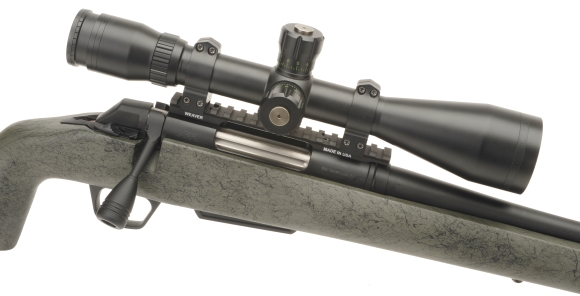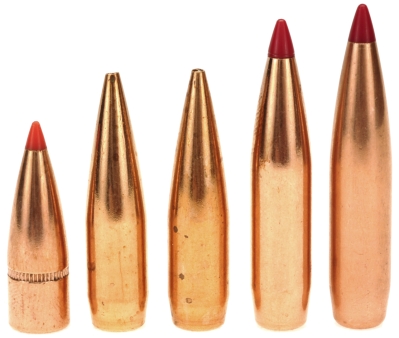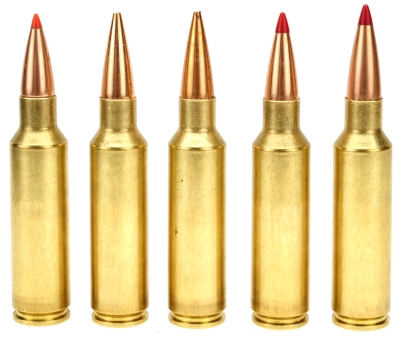The Winchester XPR Renegade Long Range SR is a… pleasant and rewarding firearm to shoot. Certainly a couple of adjectives I don’t often use.The combination of a little bit of heft, a good fitting Grayboe stock and a SilencerCo Omega 36M took the edge off of magnum report and recoil in a major way. It is a rifle that made for some very enjoyable range days. It is a rifle that would make for some very enjoyable hunting days.
The Logic of “Long Range”
There is a distinct difference between long range target shooting and long range hunting. Paper can be punched at any range and a miss means no more than an unblemished target. A miss with long range hunting could mean a wounded animal, lost to the hunter, and left to die where ever it finally fell or, even if recovered, a deer or elk with shot out hind quarters. Ethical hunting comes into play and “long range” is a relative term. The first time we participate in a hunter’s safety course, we are told, reminded… and reminded some more, that shooting distance limitations are determined by the type of game, environmental conditions, capability of the firearm, and competency of the shooter.
Personally, I am a 1,000 yard paper target guy with many… many targets left unscathed. I am only a 300 yard hunter and nothing has ever gotten away. The limitation has nothing to do with age, as I was always a 300 yard maximum hunter. I’ve never had the motivation to reach farther to see where my shooting skills ended, because that range would be marked by a failed hunt and possibly a lost, wounded animal. There are a good number of folks out there who could easily double my hunting maximum range. There are also many who just think they can. Those that can put in the time and train to get there. They know their firearms and ammunition inside and out. They are true marksman and they know how to adjust for crosswinds, temperature changes, irregular elevations and they know the anatomy of animal they hunt. Those that can’t are social media influencers.
Why all of the hunting references for the Winchester XPR Renegade Long Range SR and not competitive shooting references? From my perspective, the rifle is optimally configured for the long range hunter and is lacking the amenities associated with 1,000 yard target competition. As examples, the barrel is sporter weight and 24″ long, rather than longer and a target heavy weight. The stock does not have an adjustable comb or cant or heel/toe adjustment. All of this is a good thing because those features would be superfluous to a long range hunter and they would have unnecessarily nearly doubled the weight and price tag of the rifle.
The Winchester XPR Renegade for the long range hunter
| Cartridge | Brand | Bullet Weight Grains | Muzzle Velocity FPS | Difference FPS |
| 308 Winchester |
HMS Trophy Gold | 168 | 2740 | – |
| 300 WSM | HMS Trophy Gold | 168 | 3109 | +369 |
| 308 Winchester |
HMS Trophy Gold |
210 | 2508 | – |
| 300 WSM | HMS Trophy Gold | 210 | 2760 | +252 |
| 308 Winchester 168 Grain HMS – Point Blank Range +3″ Ordinate 249 Yards | ||||||||||||
| Yards | 0 | 100 | 200 | 300 | 400 | 500 | 600 | 700 | 800 | 900 | 1000 | |
| Velocity – fps | 2740 | 2564 | 2395 | 2233 | 2078 | 1930 | 1788 | 1653 | 1528 | 1413 | 1308 | |
| Energy – ft.-lbs. | 2800 | 2452 | 2140 | 1861 | 1611 | 1389 | 1192 | 1019 | 870 | 744 | 638 | |
| 300 WSM 168 Grain HMS – Point Blank Range +3″ Ordinate 280 Yards | ||||||||||||
| Yards | 0 | 100 | 200 | 300 | 400 | 500 | 600 | 700 | 800 | 900 | 1000 | |
| Velocity – fps | 3109 | 2919 | 2737 | 2561 | 2392 | 2231 | 2075 | 1927 | 1785 | 1650 | 1525 | |
| Energy – ft.-lbs. | 3605 | 3179 | 2793 | 2446 | 2135 | 1856 | 1607 | 1385 | 1189 | 1016 | 868 | |
| 308 Winchester 210 Grain HMS – Point Blank Range +3″ Ordinate 232 Yards | ||||||||||||
| Yards | 0 | 100 | 200 | 300 | 400 | 500 | 600 | 700 | 800 | 900 | 1000 | |
| Velocity – fps | 2508 | 2374 | 2245 | 2120 | 1999 | 1882 | 1770 | 1662 | 1560 | 1466 | 1377 | |
| Energy – ft.-lbs. | 2933 | 2628 | 2349 | 2095 | 1863 | 1652 | 1461 | 1288 | 1135 | 1001 | 884 | |
| 300WSM 210 Grain HMS – Point Blank Range +3″ Ordinate 255 Yards | ||||||||||||
| Yards | 0 | 100 | 200 | 300 | 400 | 500 | 600 | 700 | 800 | 900 | 1000 | |
| Velocity – fps | 2760 | 2618 | 2481 | 2348 | 2219 | 2095 | 1975 | 1860 | 1748 | 1641 | 1541 | |
| Energy – ft.-lbs. | 3551 | 3196 | 2869 | 2570 | 2297 | 2047 | 1819 | 1612 | 1425 | 1256 | 1107 | |
With common bullet weights, the 300 WSM offers substantial performance over the 308 Winchester. In fact, the WSM 210 grain bullet is faster, harder hitting and flatter shooting than even the much lighter 168 grain 308 Winchester. The increase in velocity also means the 300 WSM is more accurate at longer distances.
As a bullet approaches the transitional velocity from supersonic to subsonic, 1.2 Mach to 0.8 Mach, it becomes less streamlined and subsequently less stable. At reduced velocity, a bullet’s center of pressure shifts and it begins to pitch and yaw; the bullet’s nose moves up and down and side to side relative to the bullet’s path through the air. While the effect is most pronounced between approximately 1,350 fps and 900 fps, which puts that range at or near 1,000 yards, deterioration is progressive over the declining velocity range.
Increasing a bullet’s rotational speed enhances stability; a function of twist rates and velocity. Winchester set the 300 WSM twist rate at 1:10″, the same as the 308 Winchester. So the 300 WSM has a higher rotational speed and, therefore, greater bullet stability at longer ranges. Yes, that is my theory and I am sticking with it. All of this was kept in mind when developing handloads to feed the Winchester.
Handload bullet selection
All five bullets selected are expanding types as listed on the handload data table. The first, a flat base secant ogive design, the others are VLD hybrid secant/tangent ogive design. The first, a Hornady SST was selected because it provided a relatively high ballistic coefficient for a lightweight .30 caliber bullet. It was seated to its cannelure as recommended by Hornady reloading manuals.
The 125 grain bullet is not listed within Hornady reloading data for the 300 WSM, 300 Win Mag, or 300 Weatherby. However, it is listed for the 308 Win, 30-06 Springfield, 300 H&H, and 300 Remington Ultra Mag. Used with the 300 WSM, the 125 grain bullet falls within Hornady’s impact velocity range criteria, and Hornady indicates it is suitable for deer and similar size game.
The Berger VLD Hunting bullets are good for thin skinned medium and large size game. The Hornady ELD-X are a bit tougher, stay together at short distances, but will still expand appropriately at longer ranges. In any event, the Winchester XPR Renegade seemed to like the selection. The flat base, secant design is supposed to be less tolerant of seating depth and distance from rifling. The Hybrid is supposed to be less sensitive to the same. Fortunately, Hornady put a big ol’ cannelure around the bullet with a tiny sign that say “Stop Here!” when seating.
Handload Data
Warning: Bullet selections are specific, and loads are not valid with substitutions of different bullets of the same weight. Variations in bullet length will alter net case capacity, pressure and velocity. Primer selection is specific and primer types are not interchangeable. These are maximum loads in my firearms and may be excessive in others. All loads should be reduced by 5% as a starting point for development where cartridges have greater than 40 grains in capacity and 10% for cartridges with less than 40 grain capacity following safe handloading practices as represented in established mainstream reloading manuals. Presentation of these loads does not constitute a solicitation for their use, nor a recommendation.
| 300 Winchester Short Magnum MAP 65KPSI |
|
| Firearm | Winchester XPR |
| Barrel Length | 24.00″ |
| Min – Max Case Length | 2.100″ +0.000″/-0.020″ |
| Min – Max COL | 2.560″ – 2.860″ |
| Primer | CCI 250 |
| Bullet Diameter | 0.3090″ +0.000″/-0.0030″ |
| Reloading Dies | Redding |
| Bullet Type | Bullet Weight Grains |
Net H2O Grains Capacity |
COL” | Powder Type | Powder Charge Grains |
Muzzle Velocity fps |
Muzzle Energy ft/lbs |
100 Yard 3 Shot Group” |
| Hornady SST | 125 | 75.2 | 2.720 | Re 15 | 67.5 | 3549 | 3497 | 1.0 |
| Hornady SST | 125 | 75.2 | 2.720 | Superformance | 77.0 | 3571 | 3540 | 0.7 |
| Hornady SST | 125 | 75.2 | 2.720 | Win 760 | 72.0 | 3439 |
3283 | 0.9 |
| Berger VLD H | 168 | 72.1 | 2.840 | Re 16 | 66.0 | 3127 |
3649 | 0.4 |
| Berger VLD H | 168 | 72.1 | 2840 | Re 17 | 67.0 | 3236 | 3907 | 0.6 |
| Berger VLD H | 168 | 72.1 | 2840 | Superformance | 71.0 | 3219 | 3866 | 0.9 |
| Berger VLD H | 175 | 72.1 | 2.840 | Re 16 | 65.5 | 3116 | 3774 | 0.6 |
| Berger VLD H | 175 | 72.1 | 2.840 | Re 17 | 66.0 | 3228 | 4050 | 1.0 |
| Berger VLD H | 175 | 72.1 | 2.840 | Hybrid 100V | 66.5 | 3138 |
3827 | 1.2 |
| Hornady ELD-X | 200 | 67.8 | 2.855 | Re 17 | 61.5 | 2899 | 3733 | 0.7 |
| Hornady ELD-X | 200 | 67.8 | 2.855 | Re 22 | 67.0 | 2814 | 3518 | 0.5 |
| Hornady ELD-X | 200 | 67.8 | 2.855 | Superformance | 65.5 | 2848 |
3603 | 0.9 |
| Hornady ELD-X | 212 | 67.8 | 2.920 | Re 17 | 61.0 | 2870 | 3878 | 0.6 |
| Hornady ELD-X | 212 | 67.8 | 2.920 | Superformance | 65.0 | 2822 |
3750 | 0.8 |
| Hornady ELD-X | 212 | 67.8 | 2.920 | RS Hunter | 64.0 | 2817 | 3737 | 0.8 |
Hornady ELD-X 212 grain loads exceed SAAMI Maximum Cartridge Overall Length, but they are as listed in the current Hornady reloading manual. All assemblies were checked for clearance with a Hornady OAL gauge. Clearance from rifling leade was tight at 0.015″, but sufficient. Magazine clearance measured 0.050″ and no feed problems were encountered. All VLD/ELD bullets were seated to a point very close to the union of bullet ogive and shank.
I will probably pull RS Hunter from future reloading projects. Using it in a number of cartridges, it has yet to yield the velocity listed in published data. Not bad powder, certainly not a deterrent to accuracy, just less than optimal velocity. Re 16 has run just the opposite, generating listed maximum velocity at significantly less than maximum reference charges, over a number of different cartridges. Hybrid 100 also produced increased pressure, well ahead of increased velocity. Might just be the powder lots on hand.
Brass moved in less than mysterious ways
Brass was all new Federal, full length sized and trimmed to 2.090″ length. Case length loss after firing was between 0.0010″ and 1.0015″. Headspace, shoulder datum line to casehead face was 1.742 sized unfired. Fired ran 1.742″ to 1.745″ checking 20 random cases, 10% of a batch population. Case head diameter, 0.550″ new, sized increased to a very uniform 0.555″ when fired. Case head changes as an indication of pressure are based on starting with once fired brass, not new brass, so no useful numbers here. Case shoulder diameter, 0.5340″ unfired, grew to 0.5410″ to 0.5425″. There was no obvious dimensional change that tracked to bullet weight or velocity and nothing I would label as exceptional.
Wrap up
The Winchester XPR Renegade Long Range SR exhibited none of the bench pressing weight and unwieldy construction so prevalent today in this class of firearm. It was nice handling, not a chore to carry and it delivered on performance. I did not have the opportunity to shoot the Winchester at protracted distances; the result of deep snow, relatively short legs and a range situated in the middle of the woods. I also wish it had not been 9°F on range days and I was not whining and complaining about my frozen nose. Nice hunting rifle and a good quality Winchester.





Email Notification